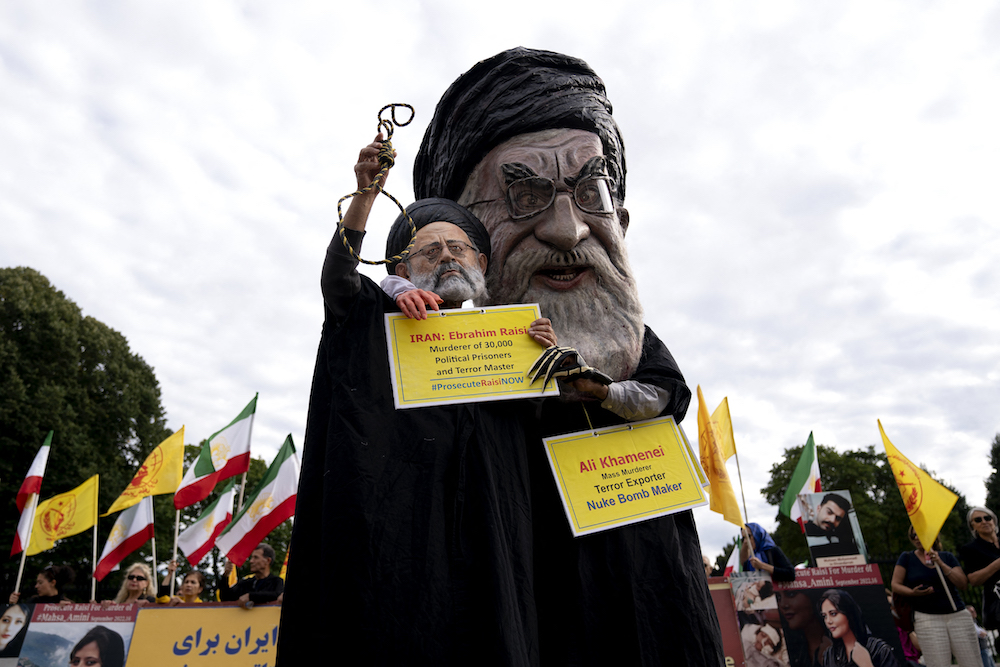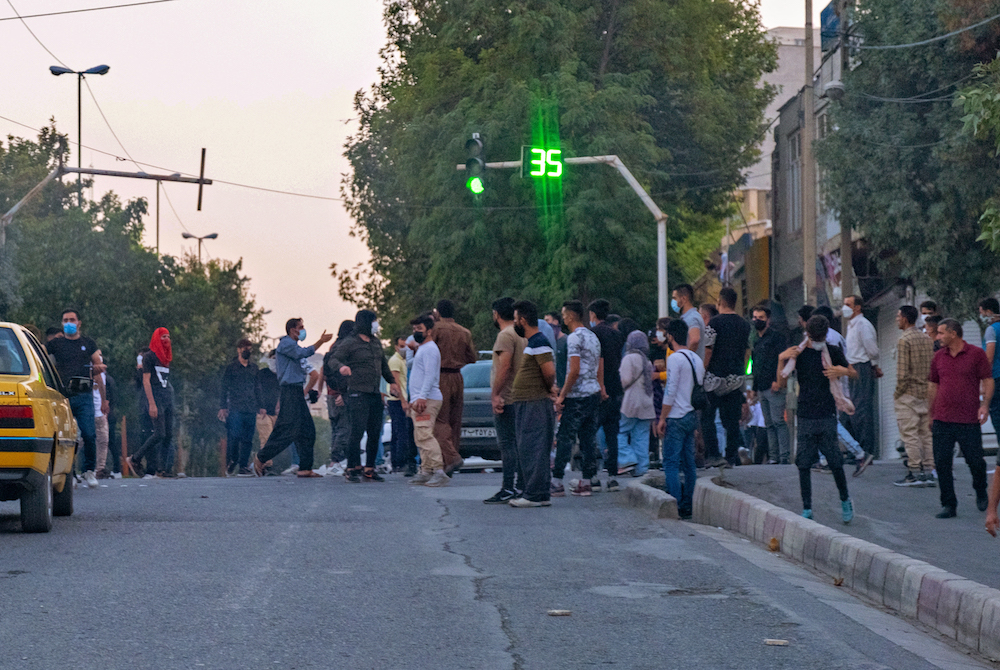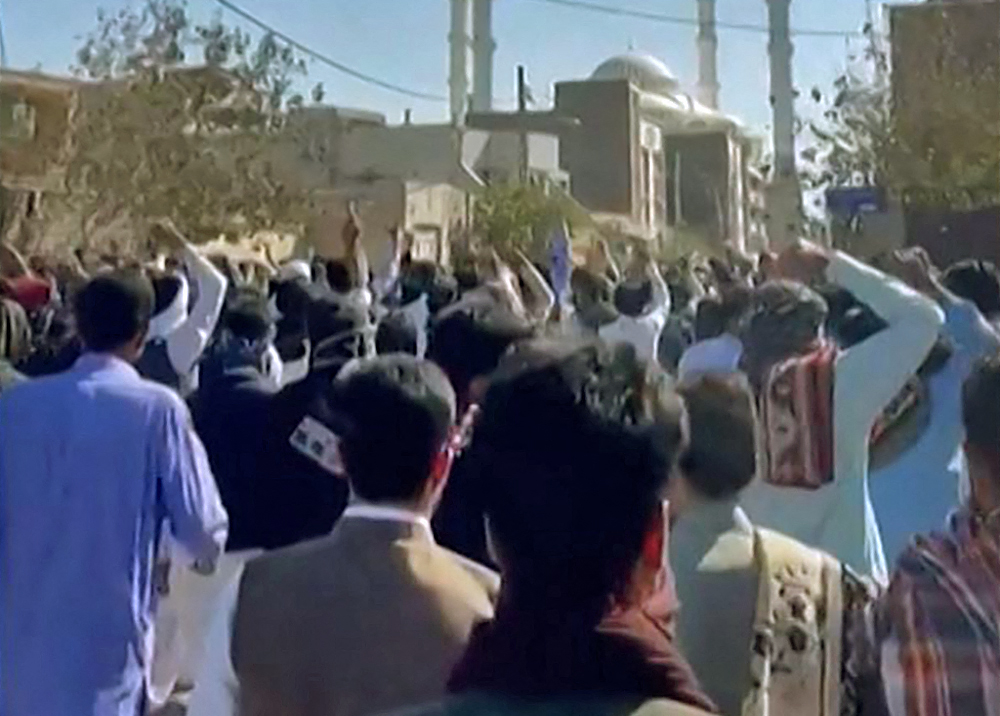RAQQA, SYRIA: Mahsa Amini, or Jina Amini, the name of a Kurdish woman killed by the Iranian morality police on Sept. 16, has echoed across social media in support of the protest movement that is posing the biggest challenge to the clerical rulers in years.
To Iranian law enforcement, Amini was just a nameless member of an ethnic minority that has been oppressed for decades. Little did they know that her death at the hands of one of its units would spark a massive uprising with the potential to topple the regime itself.
On Sept. 13, the 22-year-old Amini was arrested in Tehran — allegedly for failing to wear a veil properly, which is mandatory in Iran. Her brother, whom she had visited, was told she would be taken to a detention center and released after an hour. Two hours later, she was in a coma.
Three days later, she was dead.
Though the Iranian regime reported that she died from pre-existing medical conditions, leaked testimonies from her co-detainees and CT scans show that she was severely beaten and suffered a skull fracture and brain hemorrhage.
The death of Amini immediately sparked a massive wave of protests across Iran. Civil unrest erupted throughout the country, from the western Kurdistan (or Kordestan) province, of which Amini was a native, to central Iran and Sistan and Balochistan province in the south.

According to an activist in Kurdistan, who wished to remain anonymous for security reasons, the protests began as Amini’s body was buried.
“People started chanting the Kurdish slogan of ‘Women, life, freedom,’ and many other nationalistic slogans during her burial ceremony. Later they took to the streets of the city and gathered in front of the governor’s office,” he told Arab News.
Within hours, protests spread to other cities in the province, and on Sept. 18, the entire region went on strike, closing their shops and taking to the streets in protest. Within days, the protests spread nationwide.
The ongoing crackdown on those who do not fall into line with the Iranian regime, while the bloodiest in decades, is widely seen as the culmination of decades of oppressive treatment of minority groups by Iranian authorities.
Chapter 2, Article 15 of the Iranian constitution allows for the teaching of regional and tribal languages in schools and their use in the media. Chapter 3, Article 19 states that “all people of Iran, whatever the ethnic group or tribe to which they belong, enjoy equal rights.”
Despite supposed constitutional protection and the fact that non-Persian ethnic and linguistic groups make up nearly 40 percent of Iran’s population, minorities have been subjected to mistreatment, from political discrimination to oppression, by means of arbitrary arrest and execution.
Kurds are the third-largest ethnic group in Iran, making up approximately 10 percent of the population. Various estimates place their numbers at around 40 million, spread across Iran, Iraq, Syria, and Turkey.

The Iranian diaspora have supported protests against the Tehran regime in cities around the world. (AFP)
“The situation is so bad in Kurdistan that I don’t know where to start,” the activist said.
“Our people suffer the worst things that are beyond imagination for people from other countries. Kurds are considered third-class citizens in Iran. First, because we are Kurds; second, because we are non-Shiite Muslims or practice other Kurdish religions; and, third, because of our opposition to the central government.”
The activist continued: “We are deprived of our very basic rights as human beings. Kurdish language and Kurdish parties are banned from the system. Kurdish cities suffer from extreme poverty and unemployment which is the result of Iran’s discriminatory policies against Kurds.
“Kurdistan enjoys the least amount of development, and Kurdish society has paid a high price for the official marginalization.”
Iran’s Kurds have suffered since 1979; Kurdish parties in Iran boycotted the March 1979 referendum to create the Islamic Republic of Iran, and have been paying the price for it ever since.
Iranian intelligence has persecuted Kurds even outside its jurisdiction. In 1989, a Kurdish politician and leader of the Democratic Party of Iranian Kurdistan was assassinated in Germany.

Demonstrations have taken place across Iran, including in the Kurdistan capital Sanandaj. (AFP)
His successor and three other Kurdish opposition figures were also killed three years later, and no fewer than 10 Iranian Kurdish dissidents have been assassinated outside Iran since 1989.
Though the current wave of unrest began in Kurdistan with the death of a Kurdish woman, the Iranian regime’s persecution of minority groups has spread beyond the Kurdish minority.
In May 2022, a wave of protests against deteriorating economic conditions swept Iran, and a spike in executions came in its wake. However, minority groups were disproportionately targeted by security forces, according to the human rights organization Iran Human Rights, or IHRNGO.
The Baloch people, a primarily Sunni Muslim group that inhabits the southern region of Baluchistan in Iran, make up only two percent of the population.
It has long suffered from economic underdevelopment, having both the lowest Human Development Index and gross national income per capita of all of Iran’s provinces, according to 2019 statistics from Netherlands-based Global Data Lab. Despite this, they have been subjected to egregious human rights violations.
A June report by IHRNGO stated that executions reached their five-year peak in Iran this year. The number has jumped from 110 in all of 2021 to 168 in the first six months of 2022 alone. Arab, Kurdish, and Baloch minorities made up the majority of executions, with Baloch prisoners accounting for 22 percent of executed people.
Arabs, too, comprise around two percent of Iran’s people, and have faced oppression and discrimination. Most of them reside in the Khuzestan province, which is rich in oil resources and a major industrial hub.
FASTFACTS
* Ethnic Persians account for 60% of Iran’s 86.7 million inhabitants.
* Ethnic Azeri, Kurd, Lur, Baloch, Arab, Turkmen and Turkic tribes make up the rest.
Despite this, the province suffers from widespread poverty and unemployment, according to Arab MP Mohammad Saeed Ansari, who claimed that around half of oil workers are brought in from outside the province and that Arabs are often denied employment opportunities there.
The UK-based Minority Rights Group International reported that nearly a quarter of a million Arabs in Khuzestan have been displaced by large government infrastructure projects.
The leader of an Arab separatist movement in Iran, Ahmed Molla Nissi, was assassinated in front of his home in The Hague in 2017, adding to the long list of foreign assassinations of minority dissidents by Iran.
In July 2021, at least nine people were killed in Khuzestan as they protested, demanding access to clean water, according to Human Rights Watch.
Amid the current unrest, protests have broken out in Khuzestan, with many oil and petrochemical facilities on strike and their workers taking to the streets. On Oct. 12, a video shared on Twitter reportedly showed a giant banner depicting Supreme Leader Ayatollah Ali Khamenei’s picture being set ablaze in Ahvaz, the provincial capital.

Cities across Iran have seen protests since 22-year-old Iranian woman Mahsa Amini died on September 16 after her arrest by the morality police in Tehran for allegedly failing to observe the Islamic republic's strict dress code for women. (AFP)
“Arab citizens live as the poorest people on the richest land — Khuzestan. This is the official name that it was given, but this place is Arabistan or Ahwaz,” Youssef Yaseen Azizi, an Arab Iranian former administrator at Tehran University and a member of the Iranian Writers’ Union, told Arab News.
“During the time of the Shah and the Islamic Republic, they brought non-Arabs to the region and settled them in the Arab cities and villages.”
Azizi believes the regime has deliberately forced Arabs and other minorities out of public life in Iran.
“Arabs only occupy around 5 percent of positions in public institutions,” he told Arab News. “The Arabic language is forbidden in schools. Many Arabs cannot find employment in the petrochemical factories simply because their name is Arabic.
“It has reached the level that they can openly say, ‘I will not employ you because you are Arab.’ Ali Khameini’s oil company in Ahwaz has hired 4,000 workers in the last ten years, and only seven of them were Arabs.”
Such attitudes might suggest Arab lives in Iran are considered cheap.

“Arabs have rebelled many times, and often ended up in prison, or were killed,” Azizi told Arab News. “We were always oppressed by the brutality of the authorities. Just 10 days ago, Emad Heydari was tortured to death in prison in Ahvaz.”
According to the website of the Ahwazi Democratic Popular Front, 31-year-old Heydari — a newly married activist from the Malashieh region — was arrested on Sept. 27 and died in prison on Oct. 6. Iranian authorities said he had suffered a stroke. Activists are unconvinced by the official narrative.
“During the 2019 protests against the increasing price of fuel, which started from the Ahwazi Arabs and spread from there, 200 Arabs were killed. They didn’t show Arabs any mercy,” Azizi told Arab News.
“The Arab press and civil society must know what is happening to us and cover it daily. They must speak on all channels and in all of their books and meetings, and support us, because we are alone. Until now, there is no channel which has covered our pain and showed it to everyone. But our resistance will continue.”
The disproportionate targeting of minority communities during the current civil unrest in Iran mirrors its past treatment of minorities. Kurdistan and Sistan and Balochistan have been subjected to the most outstanding amount of violence, according to the Critical Threats Project, an intelligence analysis project created by the American Enterprise Institute in 2009.
Two weeks after Amini’s death, a group of protestors gathered after Friday prayers in the Baloch-majority city of Zahedan to show their support for the nationwide protests and demand justice for the alleged sexual assault of a 15-year-old Baloch girl by an Iranian police commander.
Amnesty International reported that Iranian security forces opened fire on the crowd with tear gas and live ammunition, with footage showing shooters on roofs aiming at demonstrators. Between 66 and 96 people were killed and hundreds more injured in the course of just hours of what has come to be known as “Bloody Friday.”
The New York Times has since spoken with 10 residents from Zahedan, including witnesses and activists; family members of the victims; and a medic who helped treat more than 150 people for wounds.
All made the accusation that security forces fired indiscriminately on unarmed protesters and civilians with bullets and tear gas. Helicopters were also deployed, according to witnesses.
“According to residents, the violence on Sept. 30 was preceded by a smaller demonstration two days earlier, in another city in the same province, Chabahar,” the US newspaper said in a report on Oct. 14.
The Iranian regime’s heavy-handed treatment of ethnic-minority areas has only intensified as the protest movement has expanded to include broader calls for an end to conservative theocratic rule.
“I call on the international community to put more effort on recognizing our issues and help us solve them,” the Kurdistan-based activist told Arab News.
“Today the people of Kurdistan and Iran need full support to overthrow this regime.”

-----------------






















